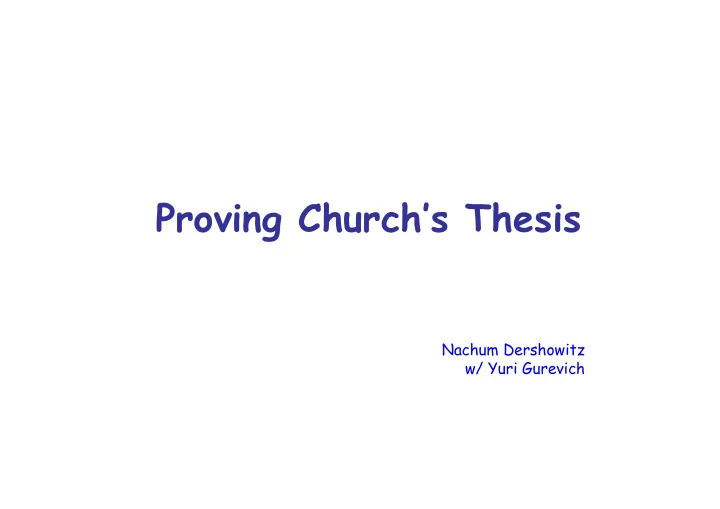

Joe Shoenfield (1991) It may seem that it is impossible to give a proof of Church’s Thesis. However, this is not necessarily the case. We can write down some axioms about computable functions which most people would agree are evidently true. It might be possible to prove Church’s Thesis from such axioms.
Joe Shoenfield However, despite strenuous efforts, no one has succeeded in doing this (although some interesting partial results have been obtained).
Formalization of Effective Algorithm
Euclid (c. -300) Euclid’s GCD algorithm appeared in his Elements . Formulated geometrically: Find common measure for 2 lines. Used repeated subtraction of the shorter segment from the longer.
Don Knuth (1966) Algorithms are concepts which have existence apart from any programming language… I believe algorithms were present long before Turing et al. formulated them, just as the concept of the number “two” was in existence long before the writers of first grade textbooks and other mathematical logicians gave it a certain precise definition.
Postulates I. An algorithm determines a computational sequence II. Elements of the sequence can be arbitrary structures III. Transitions are governed by some finite description IV. Only computable operations are given initially
I
What is an algorithm? • An algorithm is a kind of state transition system.
Knuth (1966) A computational method comprises a set of states… In this way we can divorce abstract algorithms from particular programs that represent them.
Hartley Rogers, Jr. (1966) • Roughly speaking, an algorithm is a clerical (i.e., deterministic, bookkeeping) procedure which can be applied to any of a certain class of symbolic inputs and which will eventually yield, for each such input, a corresponding symbolic output . • An example of an algorithm is the usual procedure given in elementary calculus for differentiating polynomials…
Donald Knuth (1968) A computational method consists of: 1. States Q 2. Input I ⊆ Q 3. Output O ⊆ Q 4. Transitions τ : Q → Q
terminal
State Transition >
Computation
Computation
Algorithm = Transition System I Q O
I. Sequential Time • An algorithm is a state-transition system. • Its transitions are partial functions.
Rogers For any given input, the computation is carried out in a discrete stepwise fashion, without use of continuous methods or analogue devices. Computation is carried forward deterministically, without resort to random methods or devices, e.g., dice. Virtually all mathematicians would agree that, although inexactly stated, [these features] are inherent in the idea of algorithm.
Joe Shoenfield A method must be mechanical… Methods which involve chance procedures are excluded;… methods which involve magic are excluded;… methods which require insight are excluded.
II
Church • An algorithm consists of a method by which ... a sequence of expressions (in some notation) ... can be obtained; • [each] is effectively calculable [given prior expressions]; • and where ... the fact that the algorithm has terminated becomes effectively known and • the [output] is effectively calculable.
Goal • Representation-independent axioms – Church uses numbers – Turing uses string representation – Gandy uses finite set representation – ASMs use any structure
Robin Gandy (1980) • States can be described by hereditarily finite sets • The rank of these sets is bounded • Machines can be assembled unambiguously from individual parts of bounded size • Causation is local 83
What is a state? • A state is any (first-order) structure. • All relevant information should be included in the functions and relations of the state.
Emil Post (1922) • The symbol-complexes are completely determined by specifying all the properties and relations of its parts… Each complex of the system can be completely described [by a conjunction of relations]
State encapsulates all relevant data!
[a] [f] [a] [f]
C° C°
II. Abstract State • States are (first-order) structures. • All states share the same (finite) vocabulary. • Transitions preserve the domain (base set) of states.
C° C° C F° F°
II. Abstract State • States are (first-order) structures. • All states share the same (finite) vocabulary. • Transitions preserve the domain (base set) of states. • States (and initial and terminal states) are closed under isomorphism. • Transitions commute with isomorphisms.
Abstract-State Postulate • Data is arranged in a structure of a finite signature. f g c • An algorithm is abstract, thus applicable to all isomorphic structures. ≅ x =5; s ( x )=6;… x =“101”; s ( x )=“110”;… τ τ ≅ x =6; s ( x )=7;… x =“110”; s ( x )=“111”;…
Infinitary Operations • min(a1,a2,…………..) X • min{ai|…}
III
What is a transition? • Transitions are algorithmic if they can all be described finitely (without presupposing any special knowledge).
Kleene An algorithm in our sense must be fully and finitely described before any particular question to which it is applied is selected.... All steps must ... be predetermined and performable without any exercise of ingenuity or mathematical invention by the person doing the computing.
Andrei Kolmogorov (1953) The computational operations are carried out in discrete steps, where every step only uses a bounded part of the results of all preceding operations. The unboundedness of memory is only quantitative: i.e., we allow an unbounded number of elements to be accumulated, but they are drawn from a finite set of types, and the relations that connect them have limited complexity…
III. Bounded Exploration • Transitions are determined by a fixed finite set of terms, such that states that agree on the values of these terms, also agree on all state changes. Yuri Gurevich
Recommend
More recommend